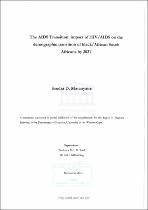| dc.contributor.advisor | Shell, R.C.-H. | |
| dc.contributor.author | Matanyaire, Sandra D. | |
| dc.date.accessioned | 2022-06-09T07:46:24Z | |
| dc.date.available | 2022-06-09T07:46:24Z | |
| dc.date.issued | 2004 | |
| dc.identifier.uri | http://hdl.handle.net/11394/9131 | |
| dc.description | >Magister Scientiae - MSc | en_US |
| dc.description.abstract | The first two official AIDS cases were diagnosed in South Africa in 1982. During the same
period of the 1980s, the black/ African population was experiencing an accelerated fertility
decline, following a period of accelerated mortality decline. Demographers invoked the
demographic transition theory to explain the observed mortality and fertility decline.
According to the demographic transition theory, mortality and fertility rates would continue
declining to low, post transitional levels with increasing modernization.
The relatively higher prevalence of HIV/ AIDS estimated among black/ African South
Africans is expected to alter their demographic transition. This research investigates the
impact of HIV/ AIDS on the demographic transition of black/ Africans by 2021. | en_US |
| dc.language.iso | en | en_US |
| dc.publisher | University of Western Cape | en_US |
| dc.subject | HIV/AIDS | en_US |
| dc.subject | Mortality | en_US |
| dc.subject | Fertility | en_US |
| dc.subject | Black/ Africans | en_US |
| dc.subject | South Africa | en_US |
| dc.title | The AIDS transition: Impact of HIV/ AIDS on the demographic transition of black/ African South Africans by 2021 | en_US |
| dc.rights.holder | University of Western Cape | en_US |

